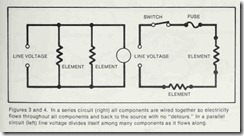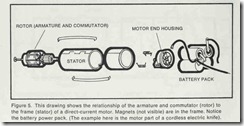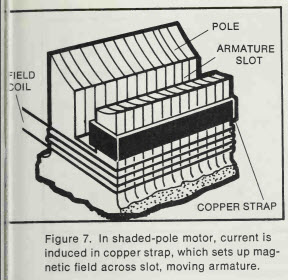1. AC-DC Universal Motor
This motor derives its name from the fact that it can run on either alternating current or direct current . Alternating current is current in which the direction of flow is reversed at regular intervals. Direct current always flows in the same direction.
The value of the universal motor lies in its ability to provide an extremely high starting torque and to attain high speed quickly while under a fairly heavy load. Large list of appliances use the universal motor, and you can see that each of them may require a high torque value and may be asked to operate under heavy loads.
Torque, incidentally, is the tendency of an object to rotate. It is a measure of turning or twisting effort imparted, for our purposes, by a motor.
The AC-DC universal motor consists of two major components: a rotor and stator. Let’s talk about the rotor first.
The rotor is a part that rotates. It doesn’t move up and down, in and out, side to side, or in any other direction than around.
In effect, the rotor of an AC-DC universal motor is made up of an armature, which is an iron core with coils of wire wrapped around it, and the commutator. The commutator and armature are together-that is, they comprise a single assembly (Figure 1).
The commutator, which is positioned on one end of the armature,consists of a series of copper bars laid out in circular fashion. They do not touch each other. Rather, they are insulated from each other by sheets of mica. The commutator is a switching mechanism but more about that in a minute.
Passing right through the middle of the armature and commutator is a shaft that sticks out of both ends. The distance that the shaft extends from each end varies from appliance to appliance, or whatever, and is really not very important.
However, what is important is that one end of the shaft is normally attached to a bearing assembly so the rotor can rotate. (But it doesn’t have to be. In some cases, for example, the shaft may have a small fan that cools the interior of the appliance.) The other end of the shaft is attached to the appliance’s working device. In the case of a food blender, for example, the end of the shaft is attached to the cutting knives.
But that “working” end of the shaft may instead be attached to a gear train which, in turn, is attached to a working element. This is true with food mixers and floor polishers.
Figure 1. The rotor of an AC-DC universal motor receives electrical energy from field coil through one brush that touches commutator . Current passes through armature and out through another brush.This establishes magnetic field, causing armature to revolve.
Now, what about the stator? Well, that’s the part of the motor in which the rotor is positioned, but keep in mind that it is positioned in this way so its movement cannot be impeded. The stator is a frame (iron, usually) containing coils (wires) called field coils.
Essentially, this is what happens:
electricity enters one of the field coils through the appliance’s line cord, which is plugged into a wall socket. Current passes from the field coil into one of two carbon segments, called brushes, which are positioned directly opposite one another on the commutator. The brushes are held in contact with the commutator by springs.
Okay, current flows through the brush to the one commutator bar the brush is touching, through the armature coil to which the armature is connected, out through another commutator bar that is in contact with the other brush, into another field coil, and back to its source (Figure 2). This means that the brushes and commutator bars, as indicated before, act as an automatic switching device that connects and disconnects each coil at exactly the right moment as the armature revolves.
Figure 2. This drawing demonstrates the circuitry of a universal motor. Refer to Figure 1 and then to this drawing, and you will understand the way this versatile motor works.
All components of a universal motor are wired together in tandem, and current at every point is the same. This arrangement is called a series circuit (Figure 3).
This differs from a parallel circuit,which is a term you’ll run across again. In a parallel circuit (which is also called a multiple or shunt circuit), components are arranged so the current divides itself between them (Figure 4).
It is interesting to note that every universal motor is made the same way the smallest and the biggest. Thus, the starter motor in your car, which is a universal motor, has the same configuration and parts as the universal motor in your vacuum cleaner.
Figures 3 and 4. In a series circuit (right) all components are wired together so electricity flows throughout all components and back to the source with no “detours .” In a parallel circuit (left) line voltage divides itself among many components as it flows along.
2. Direct Current (DC) Motor.
The direct current (DC) motor looks and acts almost like an AC-DC universal motor . It has an armature, commutator, and brushes . However, it can operate on direct current only on current which flows always in the same direction.
One of the main differences between an AC-DC universal motor and a DC motor is that most DC motors have stators consisting of a series of permanent magnets rather than field coils. This creates a magnetic field, just as field coils do, so the rotor can revolve. However, the voltage needed to get the rotor of a DC motor revolving is much lower (5 to 7 volts) than that needed by an AC-DC universal motor (115 volts).
Consider the appliances in which a DC motor is used-electric knives, electric toothbrushes, and electric shavers. These are all units which do not need a great deal of power to do work. For this reason, a DC motor provides much less torque than a universal motor.
In addition, the fact that many electric knives, shavers, and tooth brushes are “cordless” demands that the units be capable of working on battery power (Figure 5). As you know, a battery pack provides relatively low voltage.
A direct-current (DC) motor may “work” on alternating current (AC). How can this be? Some models of electric knives, toothbrushes, and shavers can be plugged into an AC wall outlet and will operate. However, the appliance is not actually functioning on alternating current.
Figure 5. This drawing shows the relationship of the armature and commutator (rotor) to the frame (stator) of a direct-current motor. Magnets (not visible) are in the frame. Notice the battery power pack. (The example here is t he motor part of a cordless electric knife) .
The alternating current is being transformed into direct current by a part inside the appliance called a rectifier (Figure 6). The same thing happens in about the same way inside the alternator of your car. The alternator actually produces alternating current, but it is converted to direct current by mechanisms called diodes. The lights, radio, and all other accessories in your car need direct current to work.
Inside the DC motor of an electric knife, shaver, and toothbrush is an other feature that works like a transformer operating in reverse. Rather than stepping up the voltage, voltage drops, so the appliance can operate at its normal energy level of 5 to 7 volts when plugged into the wall. At a greater voltage, the unit may be damaged.
Figure 6. This drawing shows the essential parts needed to convert AC to DC and lower current to a usable level in the electric knife shown in Figure 5. The rectifiers convert AC to DC and the transformer reduces the voltage .
3. Shaded-Pole Motor.
Shaded-pole motors are small (1/100 to 1/20 horsepower) alternating-current motors that are used where very low starting torque is needed (Figure 7). There is little or no resistance (load) imposed on the motor when it tries to get going. With small electric fans and hair dryers, for example, the only resistance the motor encounters is air and that’s not much resistance at all.
A shaded-pole motor has no commutator on its armature and no brushes . The shaded-pole winding consists of solid copper rings on each pole tip. The rings set up a magnetic field which alternately aids and opposes the main field coil. The effect is a field that produces a turning force and starts the armature spinning.
Figure 7. In shaded-pole motor, current is induced in copper strap, which sets up magnetic field across slot, moving armature.
4.Split-Phase Motor
This motor used in major motorized appliances and it is primarily employed in large units, such as washing machines. However, you might encounter one in a large electric fan.
A split-phase motor consists of two windings (coils). One is used to start the armature turning, and the other is used to keep the armature turning at a constant speed. Once the motor starts and attains running speed, the starting coil is cut from the circuit and the running coil assumes the task of keeping the motor running. This is done by means, usually, of a centrifugal switch (or governor), that has a spring-controlled arm.On the end of this arm is a contact point. When this contact point “breaks” away from a mating contact point, the circuit is broker. and the starting coil shuts off.





